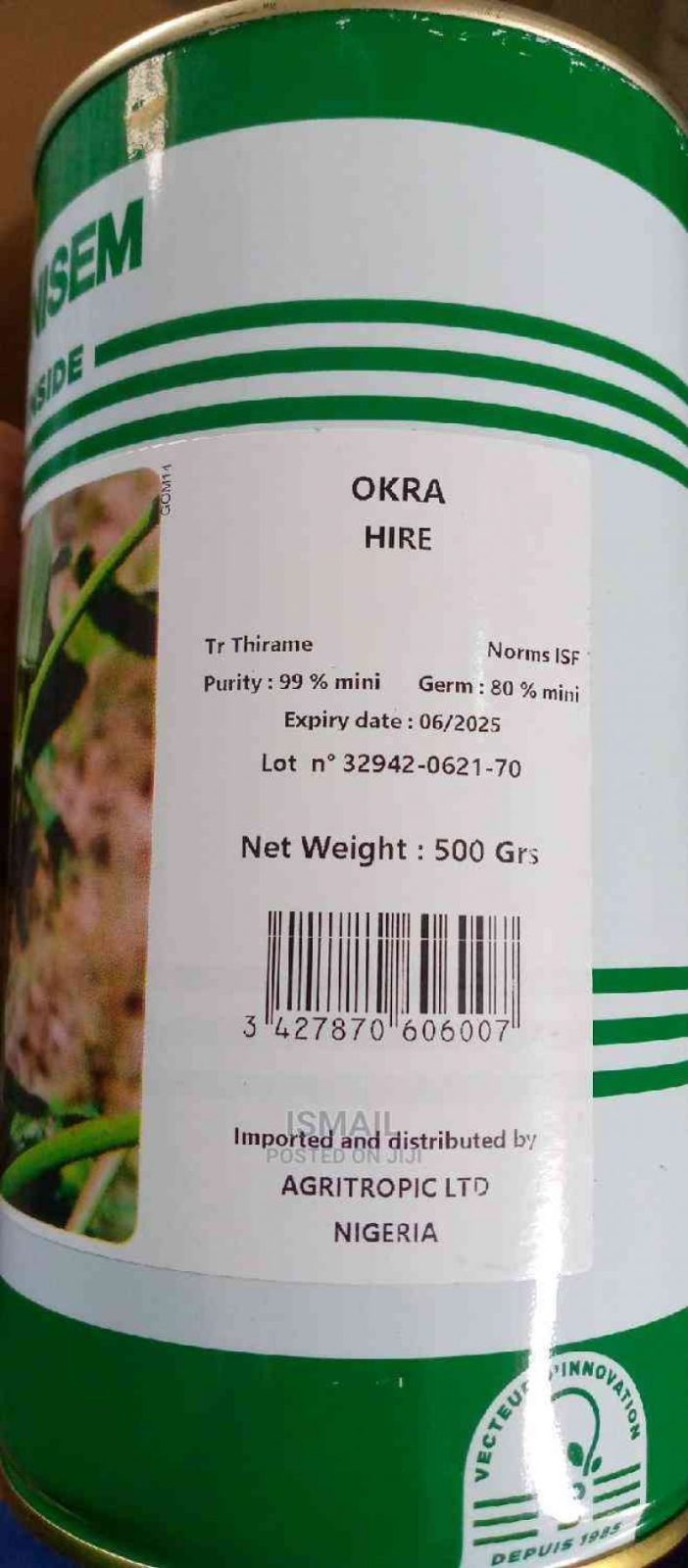No products in the cart.
Return To Shop
0
₦0.00
0
Shopping cart (0)
Subtotal: ₦0.00
Spend ₦500.00 to get free shipping Congratulations! You've got free shipping.
Log in / Sign up
Login Register
`TECHNISEM HIRE OKRA (500GRM)
₦28,999.00


TECHNISEM HOT PEPPER (SHAMSI)
₦7,500.00
TECHNISEM HIRE OKRA (500GRM)
₦28,000.00
25 people are viewing this product right now
Please, activate Compare option to use this widget.
SKU: technisem-hire-okra-500grm-2 Categories: Seeds & Seedlings
Share:
TECHNISEM HIRE OKRA
TECHNISEM HIRE OKRA is a smaller and useful okra, even in hot circumstances. This assortment, coming from the Ivory Coast, produces smaller octagonal natural products with dainty endings. It stays exceptionally useful under hot circumstances. The organic product is conservative with a slim consummation, Octagonal shape, Slightly bushy, and dull green. The organic product develops between 60 to 65 days subsequent to planting (as per the environment and national conditions)
Purchase Now!
TECHNISEM HIRE OKRA is minimal and useful okra, even in hot circumstances. This assortment, coming from the Ivory Coast, produces minimal octagonal organic products with dainty endings. It stays exceptionally useful considerably under hot circumstances.
Highlights of Okra Hire
Natural product: Compact with slim consummation, Octagonal shape, Slightly furry, Dark green
Development: 60 to 65 days subsequent to planting (as indicated by environment and nation conditions)
CROP CYCLE: 110 to 150 days (as indicated by environment and nation conditions)
PLANT: Branched, Green to dim green stems with red spots
LEAVES: Dark green with red veins, Bicolour petiole
Developing Okra
Before planting, drench the okra seeds in water for 12 to 18 hours to relax their hard seed coat. Splashing helps dampness ingestion and germination.
Plant okra in the spring or late-spring once the danger of ice has passed. To keep the seeds from spoiling, the dirt ought to have warmed to something like 65 degrees. Grounds-keepers in cool districts might need to begin okra seeds inside in peat pots four to about a month and a half before the area’s last ice date.
In the case of purchasing okra plants, buy those that are begun in compartments, for example, peat pots that can go into the ground. Upsetting okra’s foundations hampers development.
Okra can develop from three to six feet tall. Pick a nursery place where its shade won’t hurt other sun-cherishing plants. Plant the seeds one inch somewhere down in lines that are three feet separated. The seeds by and large sprout in two to 12 days. Okra will fill in many soil types, so mulch and prepare depending on the situation.
When the plants begin to develop, meager them so they are separated 12 to 18 inches separated.
Okra flourishes in the full, warm sun. Standard watering is required and is especially basic during blossoming and case advancement. During broadened droughts, a week by week profound drenching is advantageous.
Crop revolution and great soil the board assist with controlling sicknesses. Okra is helpless to shrink, root-hitch nematode, and Southern stem curse. It is typical for okra to draw in different scarabs and worms. Observe consistently for pervasions and treat them fittingly.
Gathering Okra
Okra arrives at development in 50 to 65 days. The plants can deliver for ten to 12 weeks. It develops and bears seed cases until ice, which rapidly turns them dark and kills them.
Begin gathering a couple of days after the okra sprouts blur. By then, the seed cases should be delicate and a few inches long. Pick the units to some extent each and every day, as they rapidly abandon delicate to intense the greater they develop. Handle okra tenderly. The units wound without any problem.
Eliminate old seed units so they don’t restrain new cases from creating. For most extreme yield, prune more seasoned appendages underneath the all around gathered cases.
All okra assortments have spines, so wear gloves while picking the units. The cowardly assortments have less spines on the actual cases, yet spines on different pieces of the plant make wearing gloves and long sleeves a smart thought.
Putting away And Using Okra Hire
Try not to wash okra. Wet units become foul and form rapidly. Refrigerate dry okra in punctured plastic packs. Use inside a couple of days before the cases’ edges and tips begin to turn dull.
Due to the long developing season and generous creation, four or five plants ordinarily produce sufficient okra for most families. More plants might be required, however, to can or freeze okra for use throughout the colder time of year.
While old seed units can’t be eaten, they are ideal for dried blossom game plans
Frequently Asked Questions (FAQs) for TECHNISEM HIRE OKRA
What is TECHNISEM HIRE OKRA?
TECHNISEM HIRE OKRA is a compact and heat-resistant okra variety from the Ivory Coast. It produces small, octagonal pods with delicate tips that stay tender even in hot weather.
What are the benefits of TECHNISEM HIRE OKRA?
- Compact size: Grows well in smaller gardens.
- Heat tolerance: Maintains tenderness even in hot climates.
- Fast maturity: Reaches harvest in 60-65 days.
- High yield: Produces okra pods for 10-12 weeks.
How do I plant TECHNISEM HIRE OKRA seeds?
- Soak seeds in water for 12-18 hours before planting.
- Plant seeds in spring or late spring after the danger of frost has passed.
- Plant seeds 1 inch deep in rows 3 feet apart.
- Thin seedlings to 12-18 inches apart when plants establish.
How do I care for TECHNISEM HIRE OKRA plants?
- Provide full sun and regular watering, especially during flowering and pod development.
- Mulch around plants to retain moisture and suppress weeds.
- Harvest okra pods when they are young and tender, a few inches long.
- Pick pods regularly to encourage continued production.
How long does it take to harvest TECHNISEM HIRE OKRA?
Pods mature in 50-65 days after planting. Plants continue to produce for 10-12 weeks.
Only logged in customers who have purchased this product may leave a review.

Reviews
There are no reviews yet.